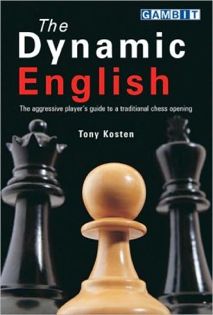Dynamic English, The
Tony Kosten

For amateurs, the question of a workable repertoire comes up all the time. By workable, I mean:
* Is endless memorization necessary?
* Are the ideas clear but effective?
* Will your opponent be prepared for the lines that youve toiled over?
When playing White, a popular first move is 1.e4. However, then you are walking into your opponents home court since he knows what hes going to play (in fact, hell undoubtedly toss out his reply instantly), while you have to be ready to face the Caro-Kann, the French, all the lines of the Sicilian, 1…e5, and much more. In other words, theres a good chance that Black will be better prepared than White (who, in this case, is you).
The same thing applies to 1.d4. Here, in an effort to avoid the Kings Indian and the Nimzo and the QGD and the annoying Slav, simple lines like the Colle (1.d4 d5 2.Nf3 Nf6 3.e3) and the Torre are employed (1.d4 Nf6 2.Nf3 e6 3.Bg5). While not bad choices for White, they ultimately lack theoretical bite and, as a result, are only used rarely in higher class events.
This brings us to alternative first moves like 1.Nf3 (a favorite of IM John Donaldson and world class GM Kramnik), which is often used as a transpositional device into various other openings, and 1.c4, a move that Kasparov has successfully employed.
In my opinion, the English Opening is an excellent choice because:
* Your opponent probably wont have anything special prepared against it. Instead of thumping out his reply, hell stare vacuously at the board for a while before making up some system that will, for the most part, be rather poor.
* The ideas are simple to learn and will enrich your overall understanding of chess.
* It is sound and effective, even at the highest levels of competition.
The following quote from the author (Kosten) makes the amateur feel good by telling him just what he wants to hear: Playing the English Opening it is possible to win games with White by just adopting a piece set-up and subsequent plan with which you are familiar, sometimes regardless of your opponent’s moves.
In general, Kosten recommends 1.c4 followed by 2.g3 and 3.Bg2 (avoiding …Bb4 pins in some lines, and keeping Whites options open concerning the ultimate placement of the g1-Knight). Hes also in favor of the Botvinnik setup (White plays 1.c4, 2.g3, 3.Bg2, 4.e4, and 5.Nge2), which gives the first player three distinct plans (playing for central expansion with a well-timed d2-d4; playing for queenside expansion with b2-b4; and playing for mate via f2-f4).
By recommending a few easy-to-learn setups, Kosten indeed makes it a simple matter for the amateur to learn this rich opening. His mix of instructive prose (he talks freely about the respective plans for both sides) and clearly laid out variations (this, and the variation index at the end, makes it easy for a player to look up a line hes just tried so he can see what he did wrong) makes this the most user friendly book on the English that Ive ever seen (though dont get it confused with more serious theoretical tomes on this opening. The author is deliberately trying to steer his readers away from the mountains of variations that serve only to confuse and horrify the non-professional).
In my opinion, this is the best repertoire book on the English available, and I heartily recommend it.
